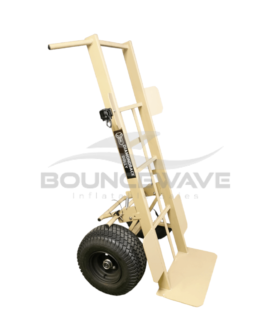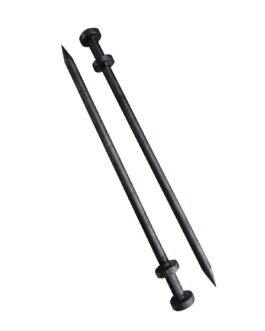A Comprehensive Guide to 4-Wheel Manual Heavy Duty Dollies: Versatility, Benefits, and Key Features
$400.00
Description
“`html
Understanding 4-Wheel Manual Heavy Duty Dollies
A 4-wheel manual heavy-duty dolly is a crucial tool in material handling, designed to transport substantial loads with ease. Unlike powered dollies or other types of material handling equipment, these dollies rely entirely on manual operation, which offers several unique advantages. Their most significant benefit is the ability to navigate tightly confined spaces where motorized equipment might not fit or be practical. This flexibility makes them indispensable across various industries, including manufacturing, warehousing, logistics, and even certain sectors of construction.
Constructed to withstand rigorous use, 4-wheel manual heavy-duty dollies are built from robust materials such as high-strength steel or reinforced aluminum. These materials ensure that the dollies can bear heavy weights without compromising structural integrity. Often, the wheels of these dollies are made from durable materials like polyurethane or rubber, designed to provide smooth movement while minimizing the risk of floor damage. The combination of robust construction and high-quality wheel materials enables these dollies to handle heavy service loads effectively.
The primary differentiation between 4-wheel manual heavy-duty dollies and other dollies lies in their capacity and size. While standard hand trucks or lighter moving dollies are suitable for smaller, less demanding tasks, heavy-duty dollies are specifically engineered to manage large, cumbersome items such as industrial machinery, bulky inventory, or oversized pallets. Their four-wheel design provides enhanced stability and weight distribution, paramount when handling these substantial loads.
These dollies typically feature a flat surface or a platform where items can be placed securely. Some models may include additional features like straps or edge guards to further secure the load during transit. The manual operation of these dollies affords users greater control, allowing precise movements even in tight quarters and providing a straightforward, reliable method for transporting heavy items without the need for complex machinery or power sources.
“`
Versatility and Applications
4-wheel manual heavy duty dollies have established themselves as indispensable tools across various industries due to their remarkable versatility. One of the primary sectors that benefit from these dollies is warehousing. In warehouses, they facilitate the movement of bulky and heavy items such as pallets, bulk containers, and large inventory goods, minimizing physical strain on workers and improving operational efficiency. By handling a wide range of weights and shapes, these dollies contribute significantly to streamlined logistical operations.
The manufacturing industry also greatly benefits from the use of heavy duty dollies. They are instrumental in transporting raw materials and finished products on the production floor. Whether it’s heavy machinery components or large-volume raw materials, these dollies ensure that items are moved safely and efficiently. Their design, featuring robust wheels and a sturdy frame, allows them to handle uneven surfaces and navigate through confined spaces, enhancing their utility on factory floors.4 Wheel Manual Heavy Duty Dolly
In the retail sector, 4-wheel manual heavy duty dollies are frequently used to move large appliances, furniture, and other oversized items. Retailers often face the challenge of relocating heavy display units or stock within stores. By employing these dollies, retailers can ensure smooth and damage-free transportation, aiding in faster setup and better space management.
The logistics and supply chain industry, dealing with the constant movement of goods, finds these dollies essential. From loading docks to distribution centers, heavy duty dollies assist in moving hefty packages and crates, thus boosting the pace of handling and dispatching goods.
The impressive versatility of these dollies stems from their thoughtful design. Equipped with durable casters and constructed from high-strength materials, they can support varying load capacities and adapt to different load sizes. Moreover, their ergonomic designs ensure that even the most cumbersome items can be maneuvered with ease, making them an ideal choice for multiple industrial applications.
Overall, the adaptability of 4-wheel manual heavy duty dollies across diverse environments underscores their importance in modern industry, helping to simplify complex tasks and enhancing operational productivity.4 Wheel Manual Heavy Duty Dolly
Key Features and Specifications
When selecting a 4-wheel manual heavy-duty dolly, understanding its key features and specifications is crucial to making an informed decision. One of the primary features to consider is the weight capacity. Heavy-duty dollies typically boast a high weight capacity, ranging from a modest 500 pounds to a robust 2,000 pounds or more. The required weight capacity largely depends on the type of loads you’ll be transporting. Ensuring the dolly can handle your heaviest anticipated load is essential for both safety and efficiency.
Wheel types significantly influence the mobility and load-bearing capability of a dolly. Common options include polyurethane, rubber, and steel castors. Polyurethane wheels are popular for their durability and smooth maneuverability on various surfaces. Rubber castors offer excellent shock absorption and quiet operation, making them ideal for delicate or noise-sensitive environments. Steel wheels provide robustness for moving over coarse terrains; however, they may not be suitable for indoor use due to their potential to damage flooring.
The frame material is another critical aspect that affects the dolly’s durability and weight. Steel frames are renowned for their strength and longevity, making them suitable for particularly heavy loads. Aluminum frames, on the other hand, offer a lighter alternative with decent durability and are often preferred for easier handling and better resistance to rust.4 Wheel Manual Heavy Duty Dolly
Handle designs also play a pivotal role in user comfort and maneuverability. Several dollies come with ergonomic handles that are adjustable or padded, which can significantly reduce strain during operation. Some models also feature folding handles for convenient storage.
Accessories and add-ons can greatly enhance the functionality of a 4-wheel manual heavy-duty dolly. Look for options such as brake systems on castors for increased safety, removable side rails for better load containment, and non-slip mats to prevent load shifting. Customizable attachments like tow bars and hitch attachments can also provide added versatility, allowing the dolly to be adapted for specific tasks.
Incorporating these features and ensuring the specifications align with your requirements will ensure you select a 4-wheel manual heavy-duty dolly that offers superior performance, durability, and ease of use.
Benefits of Using a 4-Wheel Manual Heavy Duty Dolly
The integration of 4-wheel manual heavy duty dollies into various industries offers numerous advantages that substantially improve operational efficiency and worker safety. These benefits can play a pivotal role in optimizing material handling processes and ultimately contributing to a company’s bottom line.
One of the primary benefits is the significant improvement in workplace safety. The manual heavy-duty dolly’s design allows for secure and stable transport of heavy loads, minimizing the risk of incidents such as tipping or falling objects. This stability is crucial in preventing workplace accidents, which can have serious ramifications both for employee well-being and business continuity.
In addition to enhanced safety, 4-wheel manual heavy duty dollies help increase efficiency in material handling tasks. These devices enable employees to move large, cumbersome items with ease, reducing the time and effort required for these operations. As a consequence, workflows are streamlined, and productivity is boosted, allowing businesses to meet their operational demands more effectively.
Another notable advantage is the potential for cost savings. Compared to automated alternatives, manual heavy duty dollies present a more affordable option without compromising on performance. The lower initial investment and reduced maintenance costs associated with manual dollies result in considerable long-term financial savings for organizations.
Furthermore, the use of 4-wheel manual heavy duty dollies significantly reduces physical strain on workers. By ergonomically distributing the weight of heavy loads, these dollies mitigate the risk of injuries related to lifting and manual handling. This focus on ergonomic practices not only enhances employee well-being but also decreases absenteeism and healthcare costs associated with workplace injuries.
Real-world examples underscore the practical benefits of these devices. For instance, a leading logistics company reported a 30% reduction in manual handling injuries and a 25% increase in material transfer efficiency after implementing 4-wheel manual heavy duty dollies. Such case studies emphasize the tangible impact these dollies can have in various industrial settings.
In conclusion, 4-wheel manual heavy duty dollies are a versatile solution that offer significant advantages in terms of safety, efficiency, and cost-effectiveness. Their role in promoting ergonomic practices and reducing physical strain on workers further highlights their value in modern material handling operations.






Reviews
There are no reviews yet.